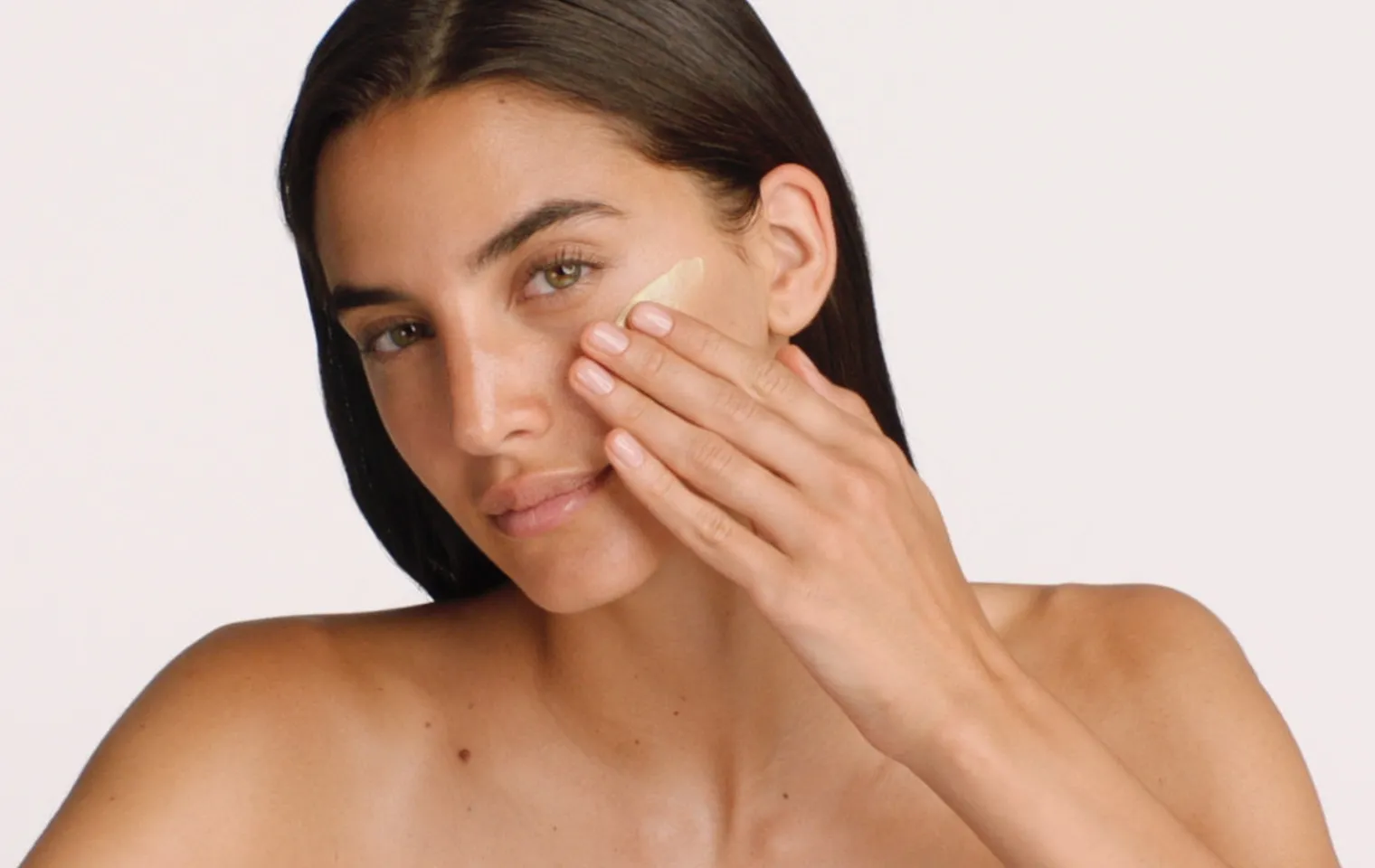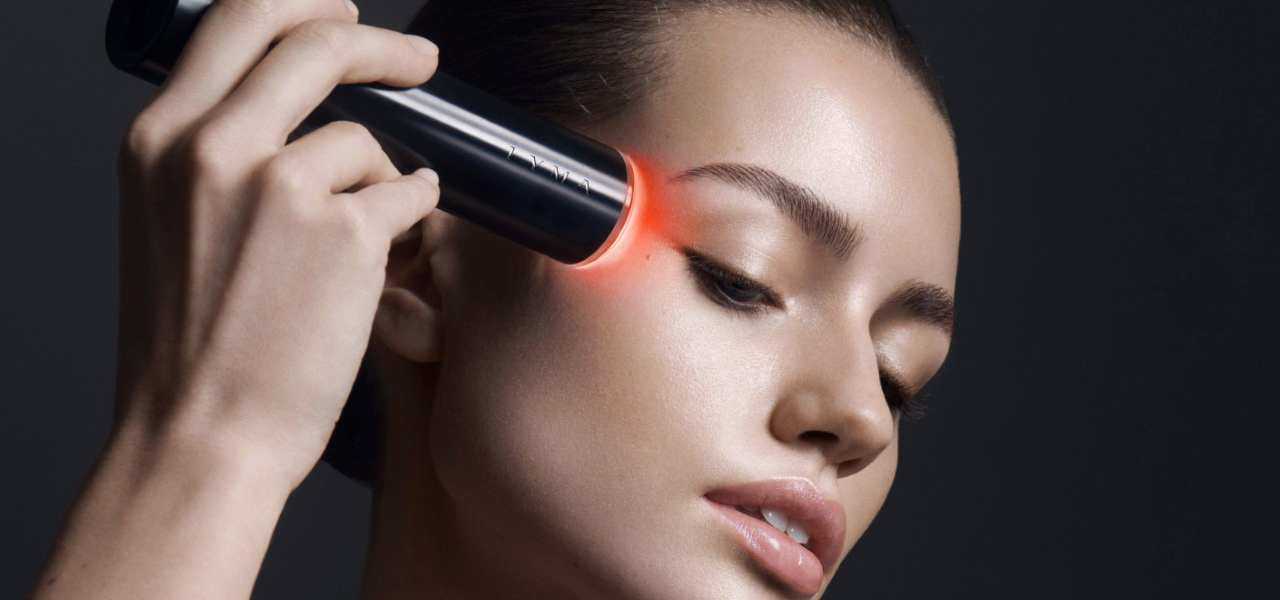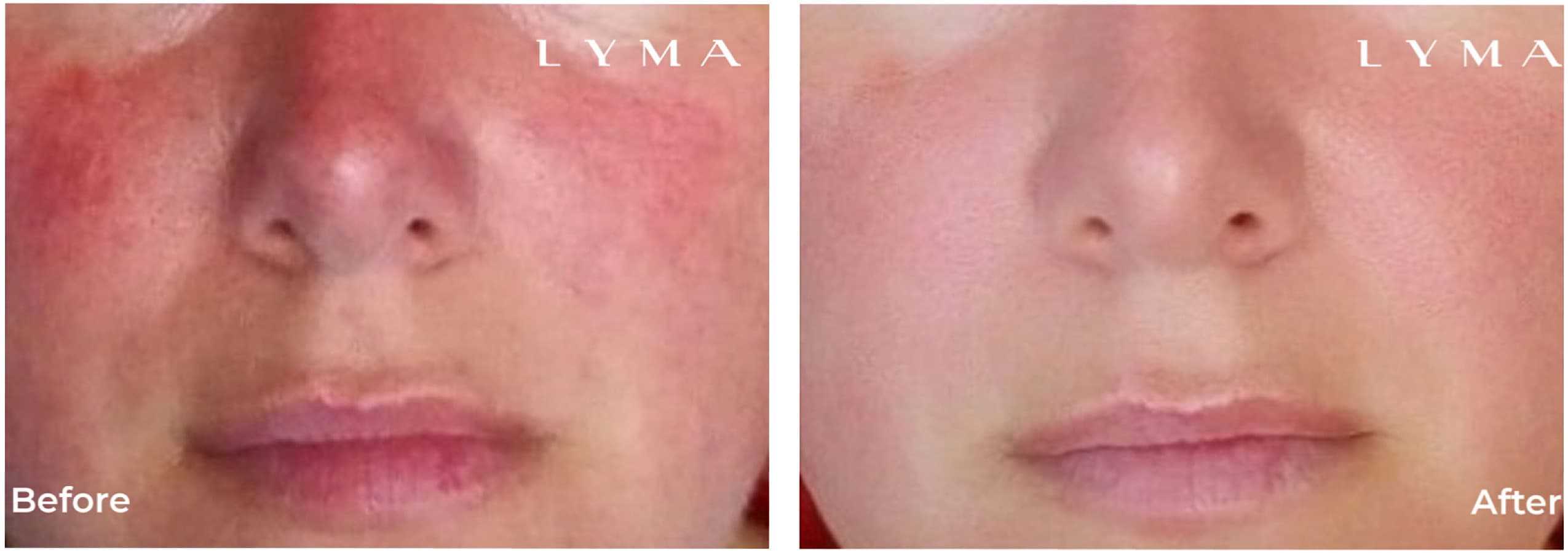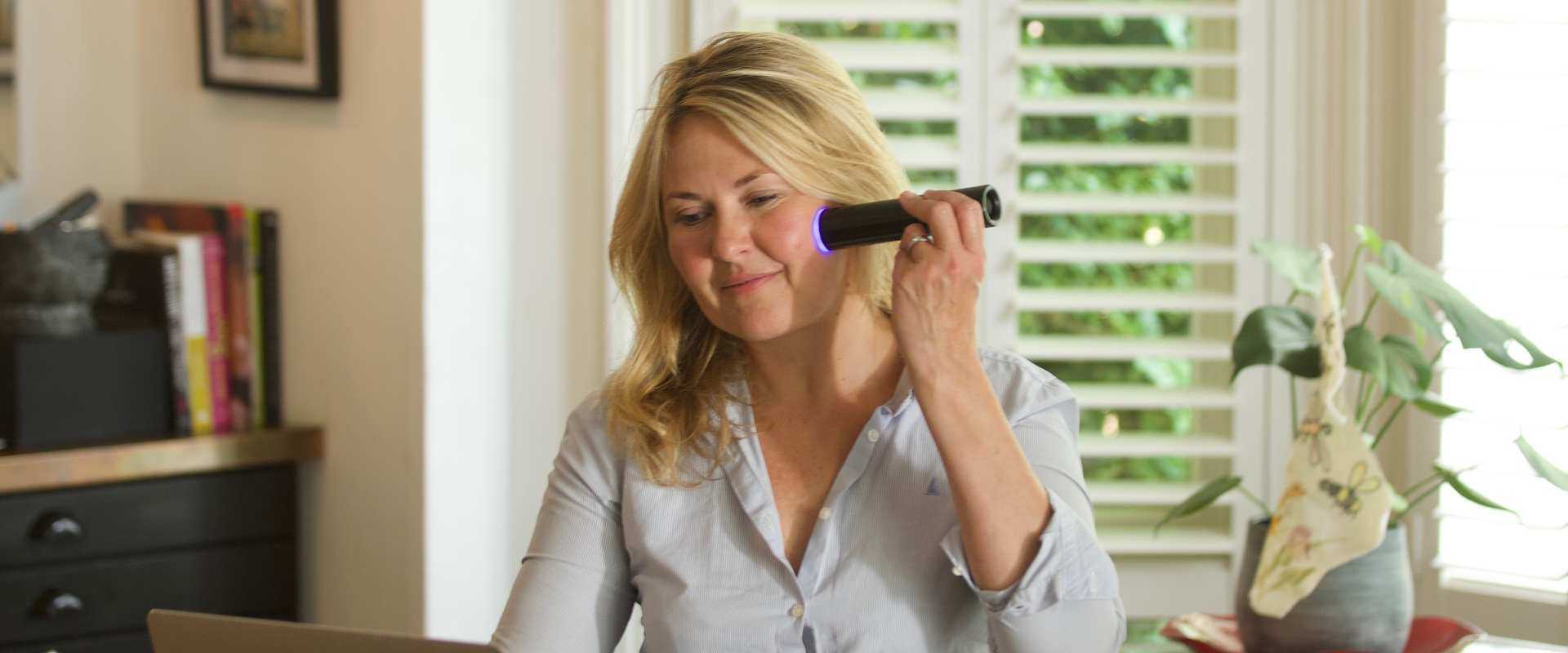12 Minute ReadEducation by Jess Lacey
20.07.22 (Updated 06.07.23)
Rosacea is a skin condition that affects millions of people across the globe. In fact an estimated 5% of the global adult population have rosacea (around 45 million people), and one in every 600 people in the UK are diagnosed with rosacea. With more people than ever seeking laser treatment for rosacea, the knowledge and treatment of this skin condition is growing rapidly. Although a chronic skin condition, there are increasingly effective ways to treat rosacea and rebalance the skin’s inflammatory response.
Rosacea is predominantly found on the face and categorised as persistent redness caused by dilated blood vessels, small bumps and sometimes pus-filled spots, similar to acne. Flare-ups fluctuate in response to diet, stress, hormones and environment, making managing the treatment of rosacea an ever-shifting target. Much like eczema, anyone can develop rosacea spots, mild rosacea or acne rosacea, as some call it, but it most commonly affects fair skin tones, individuals between 40 and 60 and more often presents in women rather than men.
There are different types of rosacea, though many people experience symptoms of more than one type:
Erythematotelangiectatic rosacea - more common in women, this intermittent flushing and redness on the central parts of the face looks similar to sunburn. This is often the first symptom of rosacea and others may or may not develop from this.
Papules and pustules - small lumpy spots and cysts similar to acne that come and go or in some cases remain long-term.
Telangiectasia - A dense network of broken blood vessels and thread veins across the nose and cheeks
Rhinophyma rosacea - more common in men, skin on the nose is thickened and the sebaceous glands are enlarged.
Ocular rosacea - symptoms revolve around the eyes and include bloodshot eyes, watery eyes, dry or itchy eyes, difficulty seeing and light sensitivity.
The signs and symptoms of rosacea include:
Small dilated blood vessels
Intense redness in the centre of the face
Bumps and pus-filled spots
Rashes across the entire face
Transient and periodic flushing that differs in its severity
Inflamed redness on the apples of the cheeks
Increased sensitivity
Stinging or burning sensation when topical products are applied

The exact cause of rosacea is not fully known but it seems to stem from a combination of both genetic and environmental influences.
There is strong evidence to suggest rosacea as hereditary. Rosacea tends to run in families and studies suggest that people with rosacea are four times more likely to have a family history of the skin condition. Rosacea is widely considered in the medical community to be associated with abnormalities of blood vessels. Blood vessels when over-dilated, cause flushing of the skin.
Rosacea is also associated with abnormal inflammation. Inflammation is a normal immune system response to injury and foreign invaders, such as bacteria but abnormal inflammation impairs the skin's ability to act as a protective barrier for the body. Research suggests rosacea is linked to abnormal inflammation and a disruption of the skin barrier.
There are certain lifestyle and environmental elements that often exacerbate rosacea and directly result in flare-ups. These most commonly include:
alcohol (in particular red wine, beer, gin and vodka)
exercise
extreme high and low temperatures
ultraviolet rays from sun exposure
hot drinks
spicy foods
emotional stress
active or fragranced skincare
long-term use of steroid creams on the face may cause more severe rosacea and thread veins

Laser treatment for skin redness is the most effective course of action, though which light therapy is best for rosacea, continues to be widely debated. The powerful energy emitted from laser beams is able to break up enlarged blood vessels, shrinking them, so they can be reabsorbed into the skin. Laser’s ability to pinpoint specific areas makes it amongst the best treatments for skin redness.
Before we describe all the types of in-clinic laser treatments that are generally expensive, painful and usually very hard to recover from, let us explore the booming world of at-home laser technologies and devices currently on the market.

The ongoing and fluctuating nature of skin redness makes home treatment an ideal option. Investing time and money into a course of clinical laser treatment for skin redness is likely to achieve good results but the ensuing maintenance can best be managed at home with a powerful, yet safe device. What’s more, lasers for mild skin redness can be too harsh on the skin and cause unwanted damage when targeting minimal redness and flushing.
There are hundreds of at-home devices for rosacea that work to varying levels but the most common DIY approach to treating it are LED light therapy masks and devices. LED light can seem effective at bringing down inflammation in the skin, calming redness and treating sensitivity. However, the strength of most LED devices on the current market is so low (only up to 25 MW) that they are not yet proven to be be effective on veins or blood vessels, so are unlikely to be a worthwhile treatment for advanced cases of rosacea.
There are a multitude of IPL and LED devices for at-home redness treatment but there is only one clinic-grade laser safe enough to use away from professional supervision.
Considered by scientific experts around the globe as the best at-home Laser for redness, the LYMA Laser treats and renews skin without any heat, damage or pain as clinical lasers do. This unique technology surpasses any other laser on the market in its ability to heal and regenerate skin by transferring energy directly to skin cells, rather than causing damage to trigger the healing process. What’s more, the LYMA Laser can be used every day at home as an immediate response to skin color fluctuations. This flexibility of use makes the LYMA device arguably the best Laser for redness, inflammation and flushing.

Treatment: The above image documents the impressive results from daily use of the LYMA Laser.
Results: Redness on the cheeks is completely calmed, all redness removed and the skin tone left unified and glowing.
In-clinic lasers have widely been proven as a very effective treatment for skin redness. Clinic grade lasers administered by highly trained professionals can achieve comparatively dramatic before and after results for rosacea across all presentations of the condition. Although there are a myriad of choices, when it comes to laser treatments for rosacea the most commonly used are Erbium:YAG, Pulsed Dye Lasers and IPL.
IPL
Doctors and dermatologists will often favour IPL (Intense Pulsed Light) as the best treatment for rosacea. Although IPL is not technically a laser, the use of IPL has shown significant clearing in erythema, telangiectasia and papules in rosacea. Indeed, a recent study found IPL treatment for rosacea resulted in 80% of patients seeing a reduction in redness, 78% of patients reported reduced flushing and improved skin texture and 72% noted fewer acneiform breakouts.
How quickly does IPL work for redness?
IPL commonly requires between 3-6 sessions, spaced 6 weeks apart, which can equate to between 6 and 12 months before your rosacea has been fully addressed. Some cases of skin redness will disappear after the first session but these would likely be very minor cases.
How long does IPL last?
Results of IPL usually last for approximately twelve months before maintenance appointments are required. Although redness that has been treated by IPL will not reoccur, new blood vessels can appear at any time, so further treatment is required.
PDL for redness
PDL stands for Pulsed Dye Laser which means that a special dye is incorporated to generate different wavelengths, which vary the depth to which the laser beam can travel into the skin. The laser light is absorbed by oxyhaemoglobin in the blood vessels, which sit at varying levels within the skin. Therefore being able to change this target depth, makes Pulsed Dye Lasers highly adept at erasing facial redness and vascular lesions.
Is the VBeam or IPL better for redness?
VBeam is the leading model of pulsed dye laser, widely offered for vascular conditions in dermatological clinics around the world. The VBeam works on long wavelengths to target blood vessels and shrink them. Opinion differs on which is better; the VBeam or IPL for redness . Both achieve similar results but the VBeam comes with more settings and attachments and tends to achieve those results slightly quicker than IPL. However, IPL can target larger areas of concern and appears to achieve preferable results for sun-induced redness.
CO2 lasers for redness
CO2 lasers and the Erbium:YAG are types of ablative laser widely proven to be successful at treating rhinophyma rosacea, (bulbous thickening of the skin). Ablative lasers are the most intense and destructive to skin and as such, can effectively resurface the face. By creating controlled, extensive wounding the skin is forced to generate new collagen and repair itself. Administering CO2 lasers for redness would likely be reserved for extreme cases only.
Excel laser for rosacea
The excel V™+ laser has dual wavelengths within it for treating spider veins, leg veins and redness. Firstly it contains a KTP laser which has a shorter wavelength absorbed by blood and pigment, making ktp a good laser treatment for redness. Secondly it also has a long pulse 1064nm Nd:YAG laser, made up of green light for targeting larger blue veins and blood vessels. Reported results are impressive but excel laser treatment is still very new, highly expensive and not widely available. Like all clinical lasers, the excel V laser causes purposeful damage to the skin, so considerable downtime is involved.
Laser Genesis for rosacea
Laser Genesis is the lowest setting on a Nd:YAG non-ablative laser that’s made by Cutera for redness. The heat from the laser can work to constrict blood vessels, therefore combating redness and achieving subtle results with no downtime. This is the most gentle laser treatment for rosacea that presents as mild and not overly advanced. Unlike most other clinical laser treatments, Laser Genesis can also be carried out in the summer months, when skin is tanned. Normal activity and make-up can be resumed straight away following Laser Genesis treatment, making it an increasingly popular lunch-hour skin rejuvenation treatment or to lessen redness before an event.
All in-clinic laser treatment comes with associated risks and complications. Classed as non-surgical, lasers are nonetheless still highly intensive and require due consideration and care.
The fundamental place to start is with a fully accredited, medical practitioner in a registered clinic. In fact, the British government has announced imminent legislation to enforce practitioner licensing.
The normalisation of laser treatment for skin rejuvenation can often underplay the length of time treatment takes - (often six months to a year for a full course), which can be disruptive to work and lifestyle commitments.
Risks of in-clinic laser treatment include infection, post-inflammatory hyperpigmentation, bruising, swelling and burns.
Downtime can also range from minimal to extensive, depending on the power and extent of the laser administered.
Recovery time can be slow as the skin on the face is so delicate.
Sunlight is often to be avoided and it may be required to stay indoors for days, if not weeks.
Prescription skincare and pain medication is likely, as is a complex aftercare routine of changing dressings and treating wounds.
An understandable barrier to laser treatment for redness or any other skin rejuvenation, is cost. Skin redness laser treatment cost per session ranges from £250 - £600 and the number of sessions can be as many as 6-8. There’s also the additional cost of maintenance laser treatment sessions for any subsequent redness flare-ups as well as the often ‘hidden’ costs of numbing creams, pain medication and prescription skincare following each laser treatment. These ancillary costs can be hundreds of pounds on top of the treatment course. The LYMA Laser, on the other hand, costs a flat fee and can be used for many years daily.
When selecting the right skin redness laser treatment for you, it’s highly advisable to see laser treatment before and after images and to read first-person experiential reviews. Results from consistent use of the LYMA Laser can be found here and this review from top US Beauty Editor Jancee Dunn, describes how after exhausting every medical laser and skincare product out there, the LYMA Laser finally changed her relationship with skin redness for good.

Can laser treatment cause skin redness?
No. A risk of clinical laser treatment is that it can cause post-treatment redness and inflammation but this is temporary.
Should I use a photofacial laser for skin redness?
Photofacial laser treatment is an effective treatment for broken veins and spider veins as well as burst capillaries, so it can be a good option for treatment of skin redness.
Does IPL hurt?
IPL is certainly not pain-free. Depending on the individual’s tolerance and the size and location of the area being treated, different levels of discomfort are reported from IPL. Some people experience a sensation of a slight burn or sting, others feel considerable pain.
How many IPL treatments are needed for skin redness?
The number of sessions is dictated entirely by the area size of the rosacea and the severity of each case. It’s common to require 4-6 sessions of IPL treatment for skin redness. Does skin redness come back after IPL? Yes. It is highly probable that it will return after IPL treatment, though timings vary greatly from one person to the next.
How long to see results from IPL for skin redness?
Results from IPL for skin redness can often be seen immediately but definite improvements are detectable after a week. Full results should be noticeable after 3-4 weeks, when blood vessels are reabsorbed and facial redness diminishes.